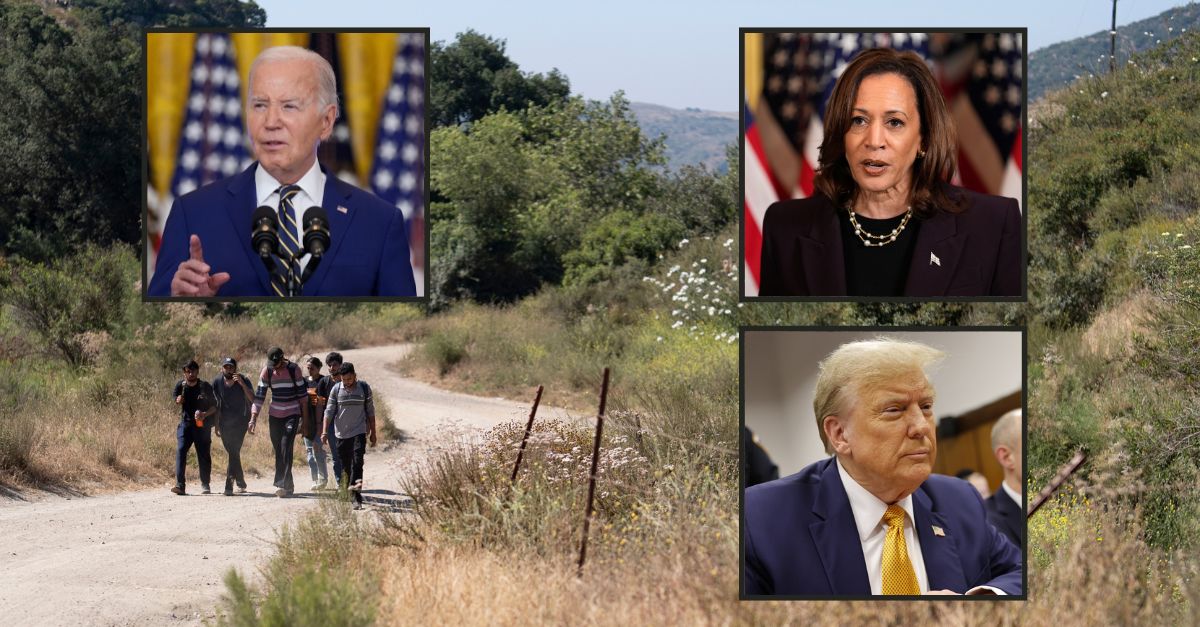
Background: FILE – Migrants seeking asylum from India walk towards a staging area before being transported and processed, Wednesday, June 5, 2024, near Dulzura, Calif. (AP Photo/Gregory Bull, File). Insets, clockwise from top left: President Joe Biden speaks about an executive order in the East Room at the White House in Washington, Tuesday, June 4, 2024 (AP Photo/Manuel Balce Ceneta). Vice President Kamala Harris speaks following a meeting with Israeli Prime Minister Benjamin Netanyahu at the Eisenhower Executive Office Building on the White House complex in Washington, Thursday, July 25, 2024 (AP Photo/Julia Nikhinson). Former President Donald Trump appears at Manhattan criminal court before his trial in New York, Tuesday, May 14, 2024 (Michael M. Santiago/Pool Photo via AP).
On June 4, 2024, President Joe Biden issued a proclamation temporarily closing the southern border of the United States. As stated during a press conference that same day, this was done in response to the increasing migrant influx into the U.S. at that border and the need to regain control over entry.
White House justification for the proclamation pointed to a system that was overwhelmed by the sheer numbers of foreign nationals seeking entry and Congress’ failure to address the problem through immigration reform, leaving Biden with no alternative but to act on his own. With over 2 million foreign nationals seeking to cross the U.S.-Mexico border in both 2022 and 2023, and over 300,000 encounters with enforcement officials in December 2023 alone, there has been much public and political debate about an immigration system in crisis. While there have been attempts at an overhaul in response to the current crisis, Congressional action has stalled.
However, public concern continues to grow, not just at the southern border, but across the country. This concern has accelerated since some southern border states have begun transporting undocumented foreign nationals in their states to states in the interior.
Because of their undocumented status, foreign nationals are mostly unable to secure lawful employment under federal law. That prohibition prevents them from obtaining the means to secure housing, food and health care on their own. The result has stressed states’ existing social systems.
The increased visibility of this human influx and its economic impact has many calling for the problem to be addressed. This has resulted in confusion over where the power to control immigration rests, what the extent of that power is and whether it is exclusive.
Some point to the president. Some point to Congress. Some claim any immigration law is subject to U.S. Supreme Court review of its constitutionality. Still others claim the states have the right to act independently of the federal government.
To understand the answer and obtain insight on how Biden’s proclamation may fare, we should begin with an examination of the Constitution.
The US Constitution and the states’ role in immigration
The creation of the United States under its Constitution made it a sovereign nation. As such, it has the right to control who enters and stays within its borders.
But from the nation’s inception, there has been tension between the federal government and the states over immigration.
In the 2012 U.S. Supreme Court case of Arizona v. United States, the court, through Justice Anthony Kennedy, addressed this tension, striking down major portions of an Arizona law that sought to greatly expand that state’s policing powers over undocumented immigrants.
Arizona, a state on the southern border, enacted the so-called Support Our Law Enforcement and Safe Neighborhoods Act, known also as S.B. 1070, in 2010. The stated purpose of the law was to address the pressing issue of large numbers of undocumented immigrants within its borders by discouraging and deterring the unlawful entry and presence of undocumented noncitizens and economic activity by foreign nationals unlawfully present in the United States.
In looking at the Arizona law, the Supreme Court recognized that federalism is central to the U.S. constitutional design — and that both the national government and state governments have elements of sovereignty that the other is bound to respect. While this can result in conflict, the Constitution’s Supremacy Clause resolves any conflict in favor of the national government.
The justices ultimately held that three provisions of the law — one that made it a crime in Arizona to be in the U.S. illegally, one that criminalized seeking employment without being authorized to do so, and a provision allowing local police officers to make warrantless arrests based on probable cause that a person was there illegally — were unconstitutional. A fourth provision, which allowed police to require verification of citizenship, was upheld.
Interestingly, in their opinions concurring in part and dissenting in part, Justices Clarence Thomas and Samuel Alito, now both part of the court’s conservative majority, took a friendlier view of Arizona’s law. Thomas would have upheld all four provisions. He saw no conflict between the ordinary meaning of the relevant federal laws and the four provisions. Alito, meanwhile, would have upheld more of the law than the majority ultimately struck down.
Given the court’s current makeup, these opinions by Thomas and Alito suggest that the states’ exercise of their police power over immigration may likely receive a friendlier reception and given greater latitude. It is also questionable whether the same result in the Arizona case would happen today.
The executive’s role in immigration
The Constitution places the entire executive function of the government in the person of the president. It directs him to ensure that the law is faithfully executed.
In the case of immigration, that means he is responsible for carrying out Congress’ immigration policy and making sure the laws it made are enforced as Congress intended. However, since the president is given no specific constitutional power over immigration, the president may only execute the law within the scope of the authority Congress has given him.
The president also has the exclusive power to recognize foreign sovereign nations. The Supreme Court identified support for the president’s exclusive power to recognize foreign sovereign nations in the Constitution’s Reception Clause. That clause directs the president to receive ambassadors and other public ministers. Further support exists in the Article II powers to negotiate treaties, nominate ambassadors and dispatch diplomatic agents. It is further substantiated by the need to speak as a nation with one voice regarding which foreign powers to recognize as legitimate and those that are not.
Under the Constitution, the president is also the commander in chief of the armed forces and state militias, when the latter are called into service of the U.S. However, the Constitution requires that while the president could send troops to militarize the border and control crossings, funding for that would be subject to congressional approval.
Because of the safeguards under the separation of powers protection, for an act of Congress to become a law, the Constitution requires presidential approval or, if vetoed by the president, that Congress be able to override a presidential veto with a two-thirds vote in both houses.
Militarization of the border should not be affected in a way that would intrude on Congress’ power to declare war or on Congress’ exclusive control over immigration and commerce, the Constitution says. Even construction of a border wall would require congressional approval and funding absent preexisting and directed appropriations.
Executive action and the border
In recognition of Congress’ exclusive power over immigration, recent executive actions — including Biden’s — have sought to work within existing congressional framework and the authority granted by Congress to the president. In his June 4, 2024, proclamation, Biden relied on and acted under Congress’ Immigration and Nationality Act of 1952 (INA) to temporarily suspend entry of noncitizens seeking asylum along the southern border and coastal lands without authorization.
Simultaneously, the secretary of the Department of Homeland Security and the attorney general jointly issued a final rule connected with the proclamation that generally restricts asylum eligibility and limits screenings for those who fear harm and seek protection. The approach is designed to speed up the processing and removal of unqualified noncitizens.
Border closure under the Biden proclamation is linked to the number of border encounters. Currently, immediate shutdown is required because the current number of 4,000 encounters exceeds the 2,500 threshold for closure.
Specifically, the president relied on the authority for his action in § 212(f) and 215(a) of the INA. These provisions, authorize the president by proclamation to suspend border entry to all or any class of noncitizens and when he finds their entry may be detrimental to the nation’s interests.
This is not the first time a president relied on this law to take action at the borders.
As recently as 2017, then-President Trump issued Proclamation 9645 to replace the “travel ban” on citizens of six Muslim-majority countries, using a similar basis under the INA to suspend entry of specific groups of noncitizens.
After court challenges and two unsuccessful attempts, Trump succeeded in getting the Supreme Court to uphold his proclamation under the INA law in the case of Trump v. Hawaii.
The court looked at the proclamation’s reliance on INA section 8 U.S.C. § 1182(f) that gave the president authority to restrict entry of undocumented foreign nationals, with the sole prerequisite being that the president make a determination that entry would be detrimental to United States interests.
The court rejected the notion that Congress required the president to explain his findings or that he had to provide a fixed end date for the ban. While the president could not override provisions of the INA, no conflict will be presumed absent a showing. Therefore, the court held that Trump’s actions were within his powers under the INA and Proclamation 9645 was a proper exercise of that authority.
In validating that authority, the court also held that the president was given broad discretion to suspend entry and that the sections relied upon created a deference to such a presidential finding that carried through to every clause when referencing presidential action.
The INA requires no end date for the suspension of entry although the proclamation described conditions that would eliminate the need for its continuance once met.
There were other reasons the court referenced in support of upholding the ban.
First, the law made no religious reference. Second, the countries named were previously designated by Congress or prior administrations as security risks. Third, before the proclamation’s issuance, the court noted it was the product of a worldwide review process and consultations with multiple cabinet officials.
Three additional features of the proclamation supported its validity in the court’s eyes. These were that since its effective date, three of the countries were removed from the ban; that there were exceptions for categories of foreign nationals; and there was a waiver program from the ban.
Will Biden’s proclamation meet with similar success — and will Congress respond?
When viewing what to do at the border, we must first look to Congress.
The Constitution places no limits on Congress’ exclusive authority to make immigration laws. Because the policy connected to such laws involves a political question, congressional action is largely entitled to immunity from judicial review.
While Congress may delegate certain authority to the President to act and exercise discretion on its behalf, Congress can take away that authority and discretion and can remove judicial review of its actions. No other branch of the federal government has such sweeping powers on the question of immigration. The others may only exercise the authority Congress gives them and intended in that regard.
Since Biden’s June 4 proclamation relies on the same law and similar provisions as Trump’s Proclamation 9645, the question is whether it will meet with the same fate if challenged. Another possibility is whether Congress will act to eliminate Biden’s authority to act as he did.
Now that Biden has dropped out of the race for president and endorsed Vice President Kamala Harris, renewed focus on the border and the president’s role is likely, given Harris’ previous efforts to stem the flow of foreign nationals at the border. Whether this will also create a renewed focus on Congress’ power remains to be seen.
For the present, however, Biden is left with few options. The rest belongs with Congress.
Robert B. Hille is a partner with Greenbaum, Rowe, Smith and Davis where he is a trial and appellate attorney. His areas of concentration include federal and state constitutional law, health care, insurance and ethics. He is also a guest analyst on the Law and Crime Network.
This is an opinion piece. The views expressed in this article are those of just the author.





